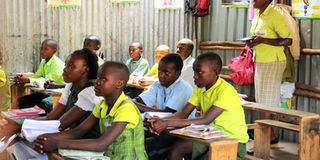400 schools likely to be shut over standards

Standard 8 pupils learning at a Bridge School in Lunga Lunga, Nairobi, on January 29, 2016. Some of the schools are being accused of non-compliance. PHOTO | NATION MEDIA GROUP
What you need to know:
- Dr Matiang’i, however, remained non-committal on whether the schools — with more than 100,000 learners and started in 2009 — would be shut.
More than 400 privately owned schools face closure over poor learning standards and failure to follow the standard curricula.
A report by the Kenya National Union of Teachers (Knut) and Education International, an NGO, called for the closure of Bridge International Academies, among other schools.
However, teachers and parents who attended the launch of the report Concern Over Growing Commercialisation and Privatisation of Education in Nairobi, protested, arguing that the schools had complied with most of the ministry’s requirements.
“When the schools started, they faced the challenges contained in the report, but we have since made some progress,” said Ms Maxmilla Baraza, a teacher at one of the schools.
Knut Secretary-General Wilson Sossion urged Education Cabinet Secretary Fred Matiang’i to follow the example of neighbouring Uganda, where the Bridge schools were ordered closed in August this year for failing to teach the approved syllabus and for employing untrained teachers.
Knut and the international NGO said the syllabus was sent directly from the United States, where the owners of the schools reside.
They further said the “structured curriculum” was delivered on tablets, with the teachers expected not to deviate from the teaching material.
“Teachers are required to recite the notes to the students and are not allowed to interact personally with the students,” said Ms Lucy Njeru, an official of Knut and a member of the research team.
Angelo Gavireilatos of Education International accused the schools of “putting profit before learning”.
“Our investigations show that the schools provide poor quality education at a cost that is not affordable to the poor,” he said.
Dr Matiang’i, however, remained non-committal on whether the schools — with more than 100,000 learners and started in 2009 — would be shut.
He said a decision on the matter would be made soon.
“I have put together a team from Quality Assurance and the Kenya Institute of Curriculum Development to look into the issue,” said Dr Matiang’i.





